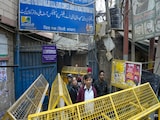- The Parish of Saint Peter the Apostle in Bantayan partially collapsed after a 6.9 magnitude earthquake
- The epicentre was 11 kilometres east-southeast of Calape in Bohol province
- The local seismology office warned of a possible minor sea-level disturbance in central islands
After an earthquake of 6.9 magnitude shook central Philippines on Tuesday, the centuries-old Parish of Saint Peter the Apostle in Bantayan partially collapsed. A video of the heritage church in Cebu with lights and parts of its outer facade collapsing is being shared widely on social media.
The local seismology office has warned of possible "minor sea-level disturbance" and has warned residents of central islands – Leyte, Cebu and Biliran – to "stay away from the beach and not to go to the coast".
The epicentre was located around 11 kilometres (seven miles) east-southeast of Calape, which is a municipality in Bohol province with a population of 33,000.
However, the Pacific Tsunami Warning Centre said that there is no tsunami threat from the earthquake and "no action is required".
According to AFP, Martham Pacilan, a 25-year-old resident of the resort town of Bantayan, said he was at the town square near a church when the earthquake hit.
"I heard a loud booming noise from the direction of the church, then I saw rocks falling from the structure. Luckily no one got hurt," he said, adding, "I was in shock and in panic at the same time, but my body couldn't move; I was just there waiting for the shake to stop."
Earthquakes are common in the Philippines, as it is located on the Pacific "Ring of Fire", an arc of intense seismic activity stretching from Japan through Southeast Asia and across the Pacific basin.
Most of the quakes that strike are too weak to be felt by humans, but when strong ones come, there is no technology available to predict them.















